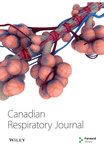Patterns and Determinants of Compliance with Inhaled Steroids in Adults with Asthma
Abstract
BACKGROUND: Patient compliance with inhaled corticosteroids (ICS) in asthma is considered to be suboptimal.
OBJECTIVES: To describe the patterns of compliance with ICS and identify factors determining the compliance to ICS in adults with asthma.
METHODS: Based on a review of the literature and interviews with asthmatic patients who require the regular use of ICS, potential determinants of compliance to ICS were identified. Questionnaires related to these determinants were then administered to a cohort of patients from three subspecialty clinics, including two from university-affiliated centres. Patients with mild-to-moderate asthma who were 15 years of age and older and required (from the physician′s point of view) ICS as maintenance medication because of persistent asthma were included in the study. Patients were followed for a period of 12 weeks. Compliance was measured using electronic devices.
RESULTS: Data from 124 patients (51 men; mean age 47±15 years; mean prescribed daily dose of ICS [fluticasone propionate] 643±385 µg) were analyzed. On average, the patients took 72±24% of their prescription. Four patterns of compliance were observed and are described: 1A -- regular compliance (n=29); 1B -- irregular compliance (n=37); 2A -- regular noncompliance (n=24); and 2B -- irregular noncompliance (n=34). Among the potential predictors of noncompliance, age was the only significant predictor (compliance increased with increasing age). There was no difference in asthma control between compliant and noncompliant patients.
CONCLUSION: Compliance to ICS in patients with asthma is often suboptimal and difficult to predict. The observations suggest that some asthmatics may be overtreated with ICS.




